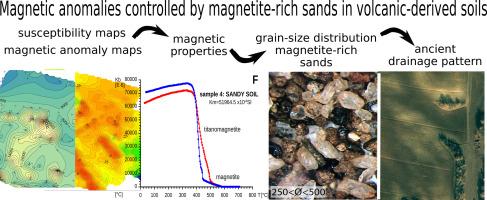由地表动力学和第四纪排水模式控制的火山土磁异常(意大利托斯卡纳)
IF 2.1
3区 地球科学
Q2 GEOSCIENCES, MULTIDISCIPLINARY
引用次数: 0
摘要
在意大利托斯卡纳、拉齐奥地区的火山土上发育的一个农业地区,由于凝灰岩、熔岩流的风化作用和碎屑颗粒的搬运作用,磁异常呈NW-SE方向的线性模式,总磁场强度在40 ~ 100 nT之间(其中一些具有偶极几何),垂直磁梯度高达50 nT。异常的位置部分与在原位和土壤样品中测量的磁化率值的高低相关,其范围从2000 × 10 - 6 SI到50000 × 10 - 6 SI。热磁曲线表明,磁铁矿是磁化率的主要载体,其可逆性证实了碎屑颗粒的火山成因。所获得的异常,虽然显示出一些不规则的正交模式,但被解释为与古代(第四纪)排水系统有关的磁性矿物浓度差异的结果。正射影像图的时间序列分析证实了这一点,表明第四纪山前阶梯式水系的发育模式与磁异常的几何形状一致。本文章由计算机程序翻译,如有差异,请以英文原文为准。

Magnetic anomalies controlled by surficial dynamics and quaternary drainage patterns in volcanic-derived soils (Tuscania, Italy)
Magnetic anomalies in an agricultural area developed over volcanic-derived soils (Tuscania, Lazio region, Italy), resulting from both weathering of tuff and lava flows and transport of detrital grains, show a linear pattern with NW-SE direction and amplitudes between 40 and 100 nT in the intensity of the total field (some of them with dipolar geometry) and up to 50 nT in the vertical magnetic gradient. The location of anomalies partly correlates with the highs and lows of the magnetic susceptibility values measured in situ and from soil samples, that range from 2000 × 10−6 SI to 50000 × 10−6 SI. Magnetite is the main carrier of the magnetic susceptibility, as inferred from thermomagnetic curves, whose reversibility corroborates the volcanic origin of detrital particles. The anomalies obtained, although showing a somewhat irregular orthogonal pattern, are interpreted as the result of the differential concentration of magnetic minerals related to an ancient (Quaternary) drainage system. This is corroborated by the analysis of time-series of orthophotographs, which indicate that the drainage pattern developed in the stepped Quaternary piedmont levels located above the present-day thalwegs shows a geometry consistent with the magnetic anomalies.
求助全文
通过发布文献求助,成功后即可免费获取论文全文。
去求助
来源期刊

Journal of Applied Geophysics
地学-地球科学综合
CiteScore
3.60
自引率
10.00%
发文量
274
审稿时长
4 months
期刊介绍:
The Journal of Applied Geophysics with its key objective of responding to pertinent and timely needs, places particular emphasis on methodological developments and innovative applications of geophysical techniques for addressing environmental, engineering, and hydrological problems. Related topical research in exploration geophysics and in soil and rock physics is also covered by the Journal of Applied Geophysics.
 求助内容:
求助内容: 应助结果提醒方式:
应助结果提醒方式:


